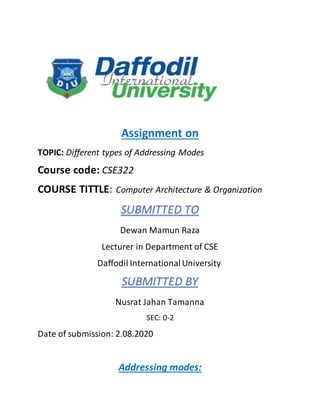
Assignment on different types of addressing modes
- 1. Assignment on TOPIC: Different types of Addressing Modes Course code: CSE322 COURSE TITTLE: Computer Architecture & Organization SUBMITTED TO Dewan Mamun Raza Lecturer in Department of CSE Daffodil InternationalUniversity SUBMITTED BY Nusrat Jahan Tamanna SEC: 0-2 Date of submission: 2.08.2020 Addressing modes:
- 2. Addressing modes are nothing but the different ways in which the location of an operand can be specified in an instruction. The number of addressing modes that a processor supports changes according to the instruction set it is based on, however there are a few generic ones that are present in almost all processors and are thus of utmost importance. They are as follows: • register (or register-direct) addressing: R1 • register indirect addressing: M[R1] • immediate addressing: data • direct (or absolute) addressing: M[address] • indirect addressing: M[M[address]] • implicit addressing: default location • relative & indexed addressing: M[R1+address] • pre-decrement, post-decrement, pre-increment, ... (1)Register (or register-direct) Addressing: In register mode ,a register contains the operand. The operand is specified with in one of the processor register. Instruction specifies the register in which the operand is stored. In register addressing the operand is placed in one of 8 bit or 16 bit general purpose registers.The data is in the register that is specifiedby the instruction. Here one register reference is required to access the data. Example: Move MOV C , A C ← A ( Here A is the operand specified in register) In register, Add
- 3. ADD B A ← A + B ( Here B is the operand specified in register) In register, Figure: Figure: Register Addressing Diagram (2)Register Indirect Addressing: The instruction specifies the register in which the memory address of operand is placed. Itdo not specify the operand itself but its location with in the memory whereoperand is placed. In this addressing, theoperand offsetis placed in any one of the registers BX,BP,SI,DI as specified in the instruction. Example: Move MOV A , M A ← [[H][L]] Itmoves the data frommemory location specified by HL register pair to A
- 4. The 8086 CPU’s let me access memory directly through a register using the register indirect addressing mode. Figure: Figure: Register Indirect Addressing Diagram (3)Immediate Addressing: The operand is specified with in the instruction.Operand itself is provided in the instruction rather than its address. In this mode data is present in address field of instruction .Designed like one address instruction format. Note:Limitation in the immediate mode is that the range of constants are restricted by size of address field. Example: Move Immediate- MVI A , 15h A ← 15h ( Here 15h is the immediate operand Add Immediate) ADI 3Eh A ← A + 3Eh (Here 3Eh is the immediate operand)
- 5. Figure: Figure: Immediate Addressing Diagram Example: MOV AL, 35H (move the data 35H into AL register) (4)Direct (or absolute) addressing: The instruction specifies the direct address of the operand.Thememory address is specified wherethe actual operand is. The operand’s offset is given in the instruction as an 8 bit or 16 bit displacement element. In this addressing mode the 16 bit effective address of the data is the part of the instruction.Here only one memory reference operation is required to access the data. Example: Load Accumulator LDA 2805h A ← [2805] Itloads the data frommemory location 2805 to A. Store Accumulator STA 2803h [2803] ←A Itstores the data fromA to memory location 2803 Example: ADD AL,[0301] //add the contents of offset address 0301 to AL Figure:
- 6. Figure: Direct Addressing Diagram (5)Indirect Addressing: The instruction specifies the indirect address where the effective address of the operand is placed. The memory address is specified where the actual address of operand is placed. The indirect addressing mode uses a register to hold the actual address that will finally be used in data moves ,the register itself is not the address, but rather the number in the register. Example: Move MOV A, 2802h A ← [[2802]] It moves the data from memory location specified by the location 2802 to A.
- 7. Figure: Figure: Indirect Addressing Diagram
- 8. (6)Implicit Addressing: It is also called inherent addressing mode. The operand is implied by the instruction. The operand is hidden/fixed inside the instruction. All actions occur in CPU. Mostof the logical Group instructions belong to this addressing mode. All actions occur within CPU. Example:Complement Accumulator CMA (Hereaccumulator A is implied by the instruction) Complement Carry Flag CMC (HereFlags register is implied by the instruction) Set Carry Flag STC (HereFlags register is implied by the instruction). (7)Relative Addressing Mode: In relative addressing mode, contents of ProgramCounter PC is added to address part of instruction to obtain effective address. Theaddress partof the instruction is called as offsetand it can +ve or – ve. When the offset is added to the PC the resultant number is the memory location where the operand will be placed. Example: Relative Addressing Mode:
- 9. Figure: Relative Addressing Diagram (8)Index Addressing Mode: In index addressing mode, contents of Indexregister is added to address partof instruction to obtain effective address. The address partof instruction holds the beginning/baseaddress and is called as base. The index register hold the index value, which is +ve. Base remains same, the index changes. When the baseis added to the index register the resultant number is the memory location where the operand will be placed. Example:
- 10. Figure: Indexed Addressing Diagram (9)Auto-increment or Auto-decrement Addressing Mode: Itis similar to register indirect addressing mode.Herethe register is incremented or decremented before or after its value is used. I. Example:
- 11. Figure: IndirectAddressing Diagram II. Example: Figure: Indirect Addressing Diagram